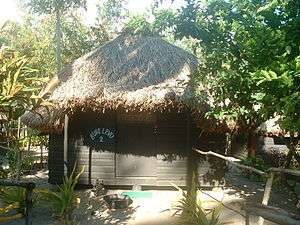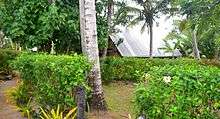Robinson Crusoe Island (Fiji)
Robinson Crusoe Island is a small island off the southwest coast of Fiji's main Viti Levu island. Originally restricted as a sacred island, Robinson Crusoe Island was first known as "Likuri Island",[1] and has a history dating back 3,500 years. A pottery site found on the island has been dated back to 1500 BC.[2] It is a traditional location among Fijian natives (the Lapita people) for traditional ceremonies and important Chielfy gatherings. More recently, it has become home to a small resort, only thanks to the High Chief - Ka Levu Tui Nadroga and the chiefly family,[3] managed in partnership with Australians but run by native Fijians.
The resort offers natural and traditional accommodation, rather than a corporate hotel style. The arrangement between the Australians and Fijians is based on the traditional systems of agreement, and allows the visitation of a limited number of tourists - mainly eco-tourists - seeking a more authentic experience of the Coral Coast and its historically significant culture. The operations of the resort therefore follow strict, eco-sustainable guidelines in regards to resource use and the prevention of pollution.[1]
It requires a short drive south of Nadi and a brief boat trip, as it is close to the coral coastline. Overnight stays, day trips and meal and entertainment tours are available from many resorts and the island features a unique tribal fire dance distinctive to the island's natural heritage. These trips are also available from Nadi and Denarau Island.
The island is more recently named after the story of Robinson Crusoe after a sailing yacht was wrecked on the nearby reef and the captain and his cat (coincidentally named Friday) took refuge on the island. The island is located in the estuary of the Tuva River, and coral reefs surround the island's seaside exposure, accessed by boat and abundant in Pacific fish and coral, with snorkeling and scuba diving being frequent activities. On the landside exposure, the island has some mangrove forests, and at its extremities curious soft sand bars and a lagoon bearing into the Pacific Ocean.
Canoes are always available for further exploration and the close relationship with local villagers allows the opportunity for mainland visits to schools, church services, and other local events.
References



Coordinates: 18°3′22″S 177°17′13″E / 18.05611°S 177.28694°E